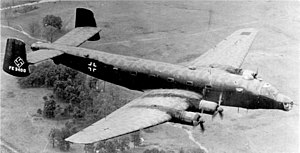| Ju 290 | |
|---|---|
 Captured Ju 290A-7 in flight with American FE markings | |
| General information | |
| Type | Maritime patrol, Transport, Heavy bomber |
| Manufacturer | Junkers |
| Designer | |
| Primary users | Luftwaffe Spain (Post war) |
| Number built | 65[2] |
| History | |
| Manufactured | 1942–1946 |
| Introduction date | August 1942 |
| First flight | 16 July 1942 (Ju 290 V1) |
| Developed from | Junkers Ju 90 |
| Variants | Junkers Ju 390 |
The Junkers Ju 290 was a large four-engine long-range transport and maritime patrol aircraft designed and produced by the German aircraft manufacturer Junkers.
Derived from the Ju 90 airliner, it was a dedicated military heavy transport developed on behalf of the Luftwaffe as a wartime replacement for Focke-Wulf Fw 200 Condor. In comparison to the standard Ju 90, it had a lengthened fuselage, more powerful engines, and a Trapoklappe - a hydraulically operated rear loading ramp. The Ju 290 initially flew unarmed; defensive machine guns were present on the majority of production aircraft following several early losses of aircraft. While originally designed for the heavy transport role, an urgent requirement for a long-range maritime reconnaissance aircraft led the Ju 290 being adapted to fulfil this mission as well. On 16 July 1942, the first prototype performed its maiden flight; the type was introduced to service shortly thereafter.
The Ju 290 was promptly deployed to bases in France for long-range reconnaissance missions in support of the ongoing Battle of the Atlantic; figures such as Admiral Dönitz demanded that the entire output of Ju 290s be made available to support Germany's U-boat campaign against Allied shipping. Shortly after the Normandy landings, the type was withdrawn from France and reassigned to transport duties. The Luftwaffe's special operations squadron, KG 200 also flew the Ju 290 for espionage purposes. In early 1945, Adolf Hitler had a specially modified Ju 290 assigned for his personal use, although he never flew aboard it. There was also some considerations to adapting the Ju 290 for the Amerika Bomber initiative, cumulating in abortive work on experimental aerial refuelling apparatus for the type as well as the B-1 high-altitude heavy bomber variant. Furthermore, it was envisioned that the Ju 290 could be used to fly the long distance route between Germany and Japan; it is contentious whether such flights actually ever occurred.
- ^ Zoeller, Horst. "Junkers–Who is who? E". The Hugo Junkers homepage. Archived from the original on 27 October 2009. Retrieved 2016-06-22.
{{cite web}}: CS1 maint: unfit URL (link) - ^ Gustin, Emmanuel. "Junkers Ju 290 and Ju 390." uboat.net. Retrieved: 4 June 2013.